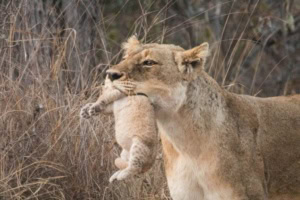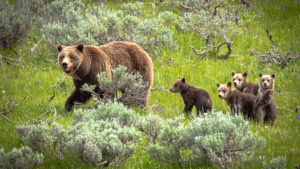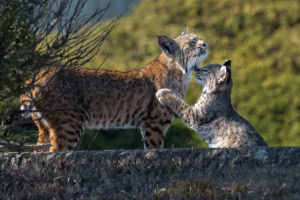Tomorrow, May 11th, is Mother’s Day. Many of the species we have here at Turpentine Creek Wildlife Refuge are some amazing mothers.
Females in the cat family are wonderful mothers in general. They tirelessly look after and protect their cubs, a very difficult job out in the wild. The amount of cubs in a litter varies (especially between species), but the average appears to be around 2-6 cubs. These defenseless young can’t even see for the first week of their lives. Mothers must protect them from many things, including other dangerous predators. Depending on their location, there are many predators that could end a cub’s life, but even their own species can be the culprit.
Male cats can become a problem. Lions, tigers, jaguars, leopards, cougars, and more have to deal with infanticide. Males will sometimes kill the offspring that isn’t their own so they can mate with that offspring’s mother. That way their chances of producing offspring are higher, and they can possibly “get rid of the competition”.
Mothers and cubs have to protect themselves not only from predation, but also from disease, competition, and exposure.
![]()
Not only do they have to protect their cubs, but they have to teach them everything they need to know in about 2 years. We don’t always think of cats being patient, but feline mothers are incredibly tolerant of their cubs.
They will help teach their young important skills by engaging in play with them. Play is one of the best ways for cubs to learn about balance, social queues, and life skills like hunting and stalking.
Lions
Typically, feline mothers raise their offspring all on their own, with lions being the exception. Lionesses will give birth outside the pride, and move their cubs’ location every few days, making sure to keep them hidden. She then brings the cubs to the pride when they’re old enough (around 1-2 months). That cub can get milk from any of the nursing females, and all the female lions help care for the cubs. The female cubs will grow up to stay in the pride, whereas males will go off on their own at about 2-2.5 years of age. Those males sometimes form coalitions with each other. Their success is dependent on how well the mothers of the pride taught them.

Leopards
Female leopards can spend up to 80% of their adult lives raising cubs. Leopards have been able to thrive as they have one of the widest ranging diets of any large carnivore, but keeping food can be a very difficult task with as many other predators as a leopard has to contend with. In Africa, leopards deal with hyenas, lions, wild dogs, and in Asia, tigers and dholes are main competitors for food. All of this makes feeding and taking care of her babies a very difficult task for a mother leopard. But she would sacrifice herself before letting her cubs die.
Grizzly Bears
Just like big cats, grizzly bears give birth to helpless young. These cubs are extremely vulnerable in their first year, and they depend on mom for everything. Female grizzly bears usually give birth to their first litter when 3-8 years old, and could have 1-4 cubs. These cubs stay with mom for 2-2.5 years, learning the ropes on how to be a bear. The term “mother bear” is there for a reason, as grizzly bear moms are very protective of their cubs.

Tigers
Like most other cat species, a female tiger will do the rearing of the cubs on her own. Male tigers meet up with females to breed, and then typically return to their solitary lifestyle. Tigers give birth to their first litter of cubs at about 3-5 years old. Like a lot of others in the cat family, a tiger mother will hide her cubs away for their first several weeks of life so they can stay safe. She will go out and search for food for them all, and when cubs are about 6 months old, they will get more and more practice with skills like hunting and stalking. At around 2 years old, they will go off on their own, and mom will begin the process again.
Bobcats
Small cats are a slightly different from big cats when it comes to motherhood. They are still protective, single mothers, but they don’t seem to have to spend as much time teaching their kittens. Bobcat kittens stay with their mothers for up to a year while they learn how to be a good predator.

Sources:
https://www.umt.edu/grizzly-bear-recovery/grizzly-bears/biology.php
https://www.npca.org/articles/2911-supermoms-and-slacker-moms-of-the-national-parks
*Published by Sara Edwards on 05/10/2025*